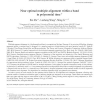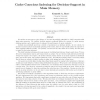101 search results - page 15 / 21 » Fast Comparison of Evolutionary Trees |
STOC
2000
ACM
13 years 12 months ago
2000
ACM
Multiple sequence alignment is a fundamental problem in computational biology. Because of its notorious difficulties, aligning sequences within a constant band (c-diagonal) is a ...
BIBE
2003
IEEE
14 years 23 days ago
2003
IEEE
Abstract— We analyze the performance of likelihoodbased approaches used to reconstruct phylogenetic trees. Unlike other techniques such as Neighbor-Joining (NJ) and Maximum Parsi...
BMCBI
2006
13 years 7 months ago
2006
Background: The neighbor-joining method by Saitou and Nei is a widely used method for constructing phylogenetic trees. The formulation of the method gives rise to a canonical (n3)...
VLDB
1999
ACM
13 years 11 months ago
1999
ACM
As random access memory gets cheaper, it becomes increasingly affordable to build computers with large main memories. We consider decision support workloads within the context of...
COMPLEXITY
2004
13 years 7 months ago
2004
: Explaining the maintenance of sexual reproduction remains one of the greatest challenges in biology. The theoretical oddity of sex is based on at least three advantages that asex...



